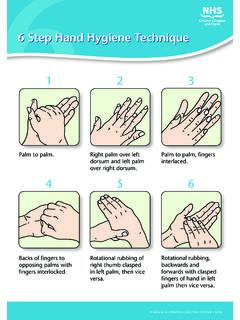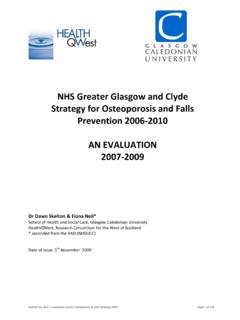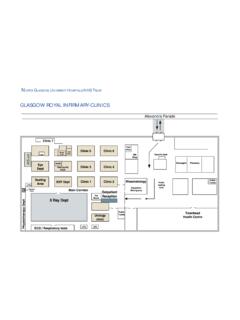Transcription of NHS Job Evaluation Handbook - Homepage NHSGGC
1 NHS Job Evaluation Handbook Second Edition October 2004 NHS Job Evaluation Handbook Second Edition October 2004 READER INFORMATION Policy Estates HR/Workforce Performance Management IM & T Planning Finance Clinical Partnership Working Document Purpose Policy ROCR Ref: Gateway Ref: 3615 Title NHS Job Evaluation Handbook Second Edition Author Agenda for Change Project Team Publication Date October 2004 Ta rget Audience PCT CEs, NHS Trusts CEs, SHAs CEs, Care Trusts CEs, WDC CEs, Special HA CEs, Directors of HR, Directors of Finance, Communication Leads, Payroll Leads, Staff Representatives Chair, Staff Representatives Secretary Circulation List Description The text of the NHS Job Evaluation Handbook , as agreed by NHS employer and staff representatives, for the new pay system for NHS non-medical staff Cross Ref NHS Knowledge & Skills Framework (NHS KSF) and the Development Review Process, NHS Terms & Conditions of Service Handbook Superceded Docs Job Evaluation Handbook First Edition (March 2003)
2 Action Required For dissemination within organisations in support of implementation of new pay system from 1 December 2004 Timing Contact Details AfC Project Team Room 2N35D Quarry House, Leeds LS2 7UE For recipient use Contents 1. Introduction to Job Evaluation 3 2. Factor Plan and Guidance Notes 8 3. Evaluating/Matching under Factor 2: Knowledge, Training and Experience 43 4. Job Evaluation Weighting and Scoring 49 5. Job Evaluation Weighting Scheme Scoring Chart 50 6. Job Evaluation Band Ranges 51 7. Guide to use of Profiles 52 8. Matching Procedure 56 9. Hybrid Matching/ Evaluation Procedure 60 10. National Protocol for Local Evaluations 61 11. Consistency Checking 66 1. Introduction to Job Evaluation 1.
3 The background: NHS pay structures before Agenda for Change Collective bargaining arrangements and associated pay structures have changed relatively little in the 50 years from the creation of the National Health Service in 1948. In line with industrial relations practice in the public sector in the immediate post-war period, there was an over-arching joint negotiating body for the sector, the General Whitley Council, and more than 20 individual joint committees and sub committees for the different occupational groups, each with responsibility for its own grading and pay structures, and terms and conditions of employment. Some developments had occurred, mainly from the early 1980s onwards, in response to increasing tensions within this system, for example: Reviews of individual grading structures.
4 The most well known of these (largely because of the high number of appeals generated) was the introduction of the Clinical Grading Structure for Nurses and Midwives, from April 1988, which brought in the current grades A to I. There were other grading structure reviews in the late 1980s and early 1990s which covered, Estates Officers, Speech and Language Therapists, and Hospital Pharmacists. There was no attempt to undertake cross-Whitley Committee reviews. The introduction of independent pay review bodies for Doctors and Dentists (1971), and Nursing Staff, Midwives, Health Visitors and Professions Allied to Medicine (1984). These took evidence from all relevant parties and recommended annual pay increases. They replaced the traditional collective bargaining approach, which was considered to have delivered unsatisfactory pay levels for some key public sector groups, but had no remit to compare pay from one group to another (even among their remit groups).
5 Staff groups not covered by pay review bodies continued to use collective bargaining over pay increases but these increasingly followed the pay review body settlements. Changes to health service legislation from 1992. These changes allowed trusts to develop their own terms and conditions and to apply these to new and promoted employees, although existing employees could choose to retain their Whitley terms and conditions. Most trust terms and conditions `shadowed the relevant Whitley arrangements in most respects, but a small number of trusts introduced totally new pay and grading structures and other terms and conditions. These were generally based on the various commercial job Evaluation systems available at the time, Medequate, Hay.
6 The result, by the mid-1990s, was a mixture of grading and pay systems, with some significant defects: Difficulty in accommodating developing jobs, such as healthcare assistants, operating department practitioners (ODPs); and multi-disciplinary team members, who might be carrying out similar roles, but whose salaries could vary significantly, depending on the occupational background of the jobholders. Inability to respond quickly to technological developments and changes to work organisation even where these were agreed by all concerned to be desirable. 3 NHS Job Evaluation Handbook Second Edition Inability to respond to external labour market pressures, causing severe recruitment and retention problems in some areas. Additional increments, which could be applied flexibly to meet such pressures, were introduced into a number of the major Whitley structures, but these were insufficient to solve the problems.
7 From a union perspective, it was also the case that the Whitley system was viewed as having delivered low pay relative to other parts of the public sector and unequal pay as between the various Whitley groups. 2. The equality background Health service pay structures and relativities were thus well established long before the advent of UK anti-discrimination legislation. Although professional and managerial groups benefited from negotiations following a 1948 Royal Commission on Equal Pay to achieve equal pay between men and women carrying out the same work, female ancillary staff were paid lower rates than their male colleagues until the passing of the Equal Pay Act in 1970, which made such practices illegal. As was allowed by the Equal Pay Act, the gap between male and female ancillary pay rates was eliminated in stages between 1970 and 1975.
8 However, as the Equal Pay Act only applied in situations where women and men were undertaking: like work , that is, the same or very similar work (who were already generally receiving equal pay) work rated as equivalent under a job Evaluation scheme (only ancillary workers in the health service were covered by job Evaluation ) it had little impact elsewhere in the health service. From 1984, the Equal Pay Act was amended to allow equal pay claims where the applicant considered that she was carrying out: work of equal value (when compared under headings such as effort, skill and decision ) to a higher paid male colleague. In 1986 and 1987 over a thousand speech and language therapists submitted equal value claims under this provision seeking to compare their work with that of clinical psychologists and hospital pharmacists.
9 The employing health authorities and the Secretary of State for Health put forward the argument that the separate collective bargaining arrangements covering each of these groups, if operated without discrimination, provided a defence to equal pay claims. This defence was contested on behalf of the applicants through the various stages of the legal appeal procedure to the European Court of Justice (ECJ). In 1993 the ECJ ruled [Enderby v Frenchay Health Authority and Secretary of State for Health (1993) IRLR 571 ECJ] that separate collective bargaining arrangements did not of themselves provide a defence to equal pay claims. A set of around 20 test cases was agreed for reference to the Independent Experts appointed by the Industrial (now Employment) Tribunal.
10 Expert witnesses for the parties also produced reports on whether or not the jobs of each of the test case applicants was of equal value to those of their male comparator(s). Three cases were actually heard by the Tribunal, which found in favour of the Applicant in each case. The remaining cases (around 400, the others having been withdrawn) were settled on the basis of the Tribunal decisions. The Equal Pay Act confines the scope of an equal claim to within the same employment . This was initially understood as meaning the same employer in the public sector. Because of this, the speech and 4 NHS Job Evaluation Handbook Second Edition language therapist applicants all selected comparators employed by the same health authority as themselves.









